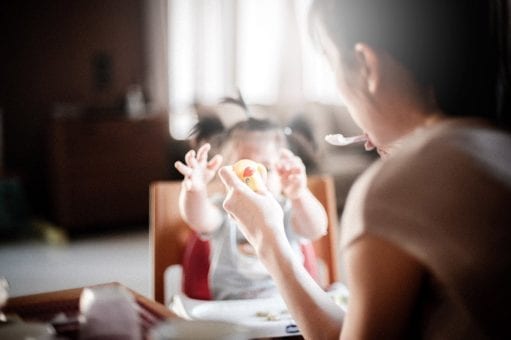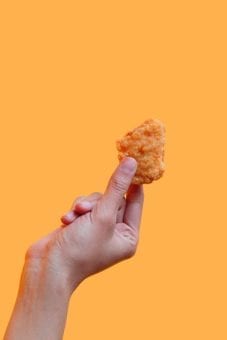When I was a child, I was called a “picky eater.” I had a small roster of foods that I would eat, without question or complaint, every time: chicken nuggets, mashed potatoes, corn, Kraft macaroni and cheese and buttered noodles. Occasionally, under duress, I would eat a few peas if they had been sufficiently soaked in butter. Any new, unfamiliar foods that were introduced were perceived as a threat. Would they be bitter? Sour? What if the texture was upsetting?
I’d venture close to smell these strange new foods before I agreed to eat them, circling with my nose in motion, like a cat sniffing a suspicious new piece of furniture in the house. I’d do a tentative taste test by sticking my finger in the food and then licking the remnants off. If I was forced or coerced into eating something that I had not tested and approved, I was known to gag dramatically, often to the point of vomiting. (Apologies to staff at Mr. Steak that time my mother tried to get me to try a bite of her steak.) Had the diagnosis been around at the time, I may have been identified as having avoidant/restrictive food intake disorder (ARFID). But in the mid-1980s, I was simply labeled difficult.
So, as someone who made mealtimes an absolute nightmare for my poor mother in the 1980s and avoided green vegetables at all costs, I was fascinated by The New Yorker’s piece,“Can Babies Learn to Love Vegetables?” by Burkhard Bilger. Unfortunately, the piece takes a long walk around the question of whether babies should learn to love vegetables.
The Flawed Search for the Perfect Baby Food
The piece begins with a baby food taste test in a decommissioned U.S. Army base, seeing how babies react to “four cups filled with raw kale leaves whipped into a smooth purée, or slurry, as food researchers call it.” The experiment we’re placed in the middle of is called, tellingly, The Good Tastes Study. From there, we learn the premise of the article: We are doing baby food all wrong. “On any given day, a quarter of American toddlers eat no vegetables,” Bilger writes. “Why don’t babies know what’s good for them? And why don’t we?”
But this requires stepping back and examining the goals of feeding children, and by extension, feeding ourselves. The premise presented by Bilger’s piece in The New Yorker is that it is obviously preferable to find the proper way to feed vegetables to babies. (Babies will and do eat baby food that contains dark, leafy greens like spinach… if those greens are mixed with fruit. Which, Bilger reminds us, is also incorrect because fruit naturally contains sugar. It is assumed that sugar, even sugar that occurs naturally in fruit and carrots, is “bad.”) And that all manner of ills are caused by children and adults simply not eating enough vegetables—or leaning too heavily on the wrong kind of vegetables.
“Babies can get fat when fed solid food too soon,” Bilger reminds us at one point. As though a fat baby is clearly and obviously a terrible thing. (This assumption, unfortunately, goes unchallenged.)
Is getting kids to eat kale really the goal here? Feeding our children is something that sounds so simple, but is so complex. This piece misses the mark in so many ways.
Feeding and Eating Are About More than Nutrition
There is a lie that permeates our culture, one that took hold around the time of the Industrial Revolution and was eagerly promoted by the diet industrial complex. The lie is that our bodies operate like machines and food is nothing more than fuel. (Bilger draws this comparison when he visits the U.S. Army’s Combat Feeding Directorate. “War fighters are a weapons system. We fuel them with food,” their director says.) But we know this is not the case. Food is fuel, but it is also social and emotional. Food builds and triggers powerful sense memories. And food can provide powerful ties to our cultures, our shared history, our ancestors and stories of the past. The dinner table is not simply a gas station for human machines. It’s a place where families bond, conflicts play out, memories are built, bodies are nourished and conversations are had.

Photo by Tanaphong Toochinda on Unsplash
From the infant years into adolescence, food is also where important boundaries are built and identities are forged. Infants and children too young to feed themselves learn to rely on their caregivers and trust that their hunger signals will garner a response that gets their needs met. Toddlers assert their bodily autonomy by refusing to eat food they dislike, or simply because they can. Power dynamics between parents and children often play out over mealtimes. (Think of rebellious announcements of vegetarianism from teenagers feeling out the identity that is right for them.) Food is so central to our growth, development and sense of self that to distill it into a mere quest to figure out how to make babies eat kale is to absurdly simplify one of the most complex parts of being human.
Chicken Nuggets are Okay! (Yes, Really!)
Amidst the science and interviews with researchers in the New Yorker article, there is a strange and very telling interlude with the founder and C.E.O. of Fresh Bellies, an organic baby food brand. The piece continually reminds us of Saskia Sorrosa’s thinness. “Slender and tan, in a denim shirt and black jeans, Sorrosa moved about the kitchen with an easy efficiency,” Bilger writes of her as she roasts beets and fennel in her kitchen to turn into a puree.
Eating beets is trying for many adults. I have never liked them. Just a week ago, I ordered a roasted vegetable dish at a restaurant, not realizing that the dish contained beets. They simply taste like dirt to me, even if they have been lovingly seasoned, roasted and caramelized in an oven. I picked them out, one by one, with my fork and placed them on the edge of my plate. Beets are great sources of nutrients! They are high in folate, magnesium, potassium, iron. But I don’t like beets, so I get those nutrients from sources that I find more enjoyable to consume, including a multivitamin. Is there a reason to make someone eat beets if they genuinely just don’t want to eat them?
To many parents like Sorrosa, there is. It’s called “palate training.” Palate training is essentially a theory that parents can shape their tastes from an early age, expose children to a wide variety of foods, and set them up to be a certain kind of eater for life. (What kind of eater? Well, obviously, the kind of eater who likes beets and fennel, and is thin.) Nutritionally, there is no real benefit to adding beets or kale or spinach into the equation before six months of age, when babies’ main source of nutrition is milk. The benefit, some argue, is that it opens children up to accept certain flavors, like the spicy foods Sorrosa was fed as a child.
At one point in the interview, Sorrosa’s five-year-old child, Alexa, threatens to undo the elaborate performance of her brand for The New Yorker. The author asks her what her favorite food is. Alexa answers, “Chicken nuggets? Hamburgers?” Sorrosa “waved her off,” stating, “We never eat chicken nuggets.” Later, her seven-year-old popped in to try to salvage the damage done by Alexa’s chicken nugget confession, naming “chicken-noodle ramen” as one of her favorite foods. Her mother initially bristles, but then says, “Oh, you mean at Momofuku! You do love that.” The message here is clear: ramen at Momofuku, David Chang’s chain of famed restaurants, is fine. Top Ramen is not. The “beef broth with mashed plantains and lime juice” Sarrosa ate as a child in Ecuador is fine, but chicken nuggets and mashed potatoes are not.
“Good” Food and “Bad” Food

Photo by Miguel Andrade on Unsplash
Dividing food into categories of “good” or “bad” can do lasting damage to children’s relationship with food. Raising children with an All Foods Fit mentality can help them become more intuitive eaters, trusting their tastes, their bodies and their instincts about food. Ideas about sugar (even sugar that is naturally found in fruit) being harmful or “addictive” is rooted in diet culture, not scientific fact. A plate of chicken nuggets or a hamburger ensures that the child eating it will be fed. Starting from a place of “good” food and “bad” food, and “good eaters” and “bad eaters,” from infancy (and even before birth) sets children up for a complicated relationship with food rather than being confident, intuitive eaters who trust their bodies. All foods, including chicken nuggets, really are absolutely fine.
Beyond Baby Food: Classism and Social Determinants of Health
There’s a lot more that factors into childhood health than whether or not they were exposed to beets and kale early enough. And the things that actually make a difference are all but ignored in this piece. The classism hinted at in the passage about Sorrosa’s reaction to chicken nuggets and ramen is much more important and pernicious than The New Yorker allows.
Social Determinants of Health refers to external forces that contribute to health. Economic stability plays an enormous role in health—children who are born into economically stable families are at a tremendous advantage, while children born into poverty are much more likely to suffer from poor health. Access to good healthcare, obviously, is important in health outcomes for children and adults. While the upper classes in our society fuss over finding the perfect baby food, much more good could be accomplished for childhood health by advocating for better housing, income equality, better maternal healthcare, paid family leave and affordable healthcare for everyone. These digs at chicken nuggets and a focus on raising children who eat like wealthy adults just further stratify parents and children alike. It distracts us from the social realities that we know actually affect our children’s health.
Looking down at parents who feed their children sugar and chicken nuggets suggests ableism. Children with autism or sensory processing issues may have strong preferences for certain foods and aversions to others. “Supertasters”are mentioned briefly by Bilger. People with differences in a specific gene may have hypersensitive taste buds that make foods with certain chemical compounds taste unbearably bitter. (I would learn later that this was a big reason for my so-called difficult childhood eating habits. I’m a supertaster.)
The focus on what parents feed their children, rather than what our society provides to ensure childhood health, is part of a bigger issue where individuals are asked to accept responsibility for social issues far beyond their control.
As for me, my sensitive taste buds dulled with age, and I was able to explore new foods, flavors and cuisines on my own timeline. I even developed a love of Brussels sprouts and kale, enjoying them both cooked and raw. No amount of bargaining or hiding them in my food would’ve been likely to make me enjoy these foods any earlier than I did. I still haven’t come around to beets, and likely never will. I made it to adulthood, with a healthy brain and body, and my childhood love of chicken nuggets has not had any repercussions to date.
Linda Gerhardt works in nonprofit technology by day, creating content, blogs, and training materials for the nonprofit sector. By night, she is a freelance writer focusing on Health at Every Size, Intuitive Eating, and fat activism. She runs a blog called Fluffy Kitten Party where she writes about health, weight discrimination, and diet culture. She lives in Northern Virginia with her husband and their adopted pets.
